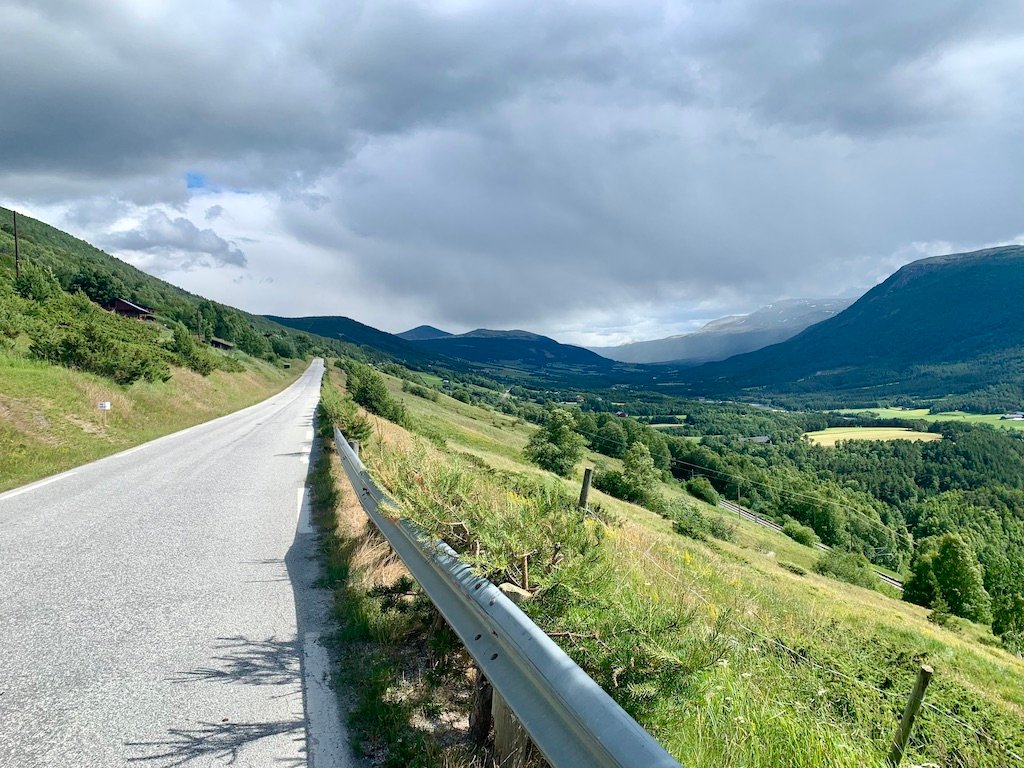When
May - September
Written by
Matthew Tolley
Distance
746km
Days
5-11
High point
1428m
Difficulty
8/10
Unpaved
<10%
Total Ascent
10395m
Ferries
2
Tunnels
25+
This is not just a route but a grand tour of Norway where every type of terrain and nature is on offer. You’ll witness some of the most diverse landscapes anywhere on the planet. Mythical gravel roads through Nordic pine forests, turn into mountainous highlands surrounded by glaciers at the top of northern Europe.
The icy world then turns into lush green valleys as you drop over 1400m down to the world’s second-longest fjord. The majestic waterfalls plunging off the mountains around you are a treat for your eyes. After some comfortable riding around the fjord the only way out is to climb again before you finally roll into Norway’s second city, Bergen, and perhaps its most beautiful. Celebrate your epic journey with some local fresh seafood at Bergen’s iconic harbour. It will be hard to find another 750km that offers so much in such a short space of time.
The Unesco World Heritage town of Røros is where this adventure begins. The old copper mining town is a good place to stock up. The remote gravel roads start pretty soon after leaving the town. The vast eastern forests which completely surround this area feel very remote and wild. Expect to see moose, birds of prey, foxes, and possibly reindeer along the way.
After about 100km you’ll get to see your first impressions of the great Rondane mountain range. It’s a wonderful feeling cycling through this area on the scenic route Rondane. The descent down towards Otta is fast and furious as you drop 800m in a very short period of time. After quiet paved and gravel roads toward Lom, the next mountain pass begins.
Sognefjellet is Norway’s most famous mountain pass road, and in calm conditions, it’s as good as any road on the planet. Glaciers will surround you as you climb up to 1428m above sea level. The descent is another fast and accelerating drop down to Sognefjorden, where you’ll find the fjord looking emerald green due to glacier meltwater. After a beautiful ride along its shore and two ferry journeys, you’ll reach another tough mountain pass. The climb up is hard and expect cold conditions on top. After riding the plateau, you’ll descend down into a beautiful valley. Expect to see sheep sitting on the road and holding up the traffic as you head to Voss.

From Voss, you have 10km on the uncomfortable E16 before turning off for the final mountain experience of the trip. The road is quiet and the views are lovely through a back road around the mountains. From Stanghelle you will be required to jump on a local train to bypass some long tunnels unrideable on a bicycle. You can get off at Trengereid and continue the journey on quiet roads to Bergen.
To shorten the journey, you could skip Rondane Scenic Route and head over the spectacular gravel section across Grimsdalen Valley. Unfortunately there is a small section on the E6 road (traffic guaranteed) to reach back onto the main route.
To skip the train journey through the impassable tunnels, you could from Voss head to Hardanger fjord and follow part of Cycle Route 3 to Bergen. Overall, It's longer, but the views around Hardanger are very special.
Halfway along the route, you will hit Sognefjellet, one of the truly great roads to cycle over. It is eighty kilometres over the highest mountain pass in Northern Europe. Plenty of accommodation and some food options are available.
After 170 km, you will hit this road. It is tucked away in the quieter eastern part of the country. It is a magnificent road winding around a wild and beautiful National Park called Rondane.
There are 2 Car Ferries on the route (both free):
IMPORTANT: At Stanghelle, you will need to jump on a train (R40) to Trengereid to bypass a series of tunnels that are prohibited to cycle. It takes 19 mins and costs around 115kr including your bike. The R40 runs every 1 to 2 hours and it is usually easy to get your bike onboard (best to book in advance but usually not essential).
I have counted 26 tunnels in total on this journey (and 3 more you skip using the train). There are none on the east side of the country. Most are found along Sognefjorden and the valleys close to Bergen.
Ones to be cautious of:
Road 27 Rondane: This is a scenic route and will have tourist traffic during the summer months. The road is wide and traffic usually travels slow enough.
Road 55 Sognefjellet: Another scenic road with tourist traffic. It can be difficult to be seen in bad weather with poor visibility. Lights and a reflective jacket are important for safety.
Road 13: This is a main road but in an area with a low population. Expect some traffic around the towns and especially close to Voss. Once again visibility is important on this road.
E16: One of my least favorite roads in Norway to cycle. Unfortunately, you have a 10km section to cycle after Voss heading to Bergen. It’s usually not that busy in this area but at the wrong time of day, it can be an unpleasant experience with cars traveling at speed. Try and ride it early morning or late evening and be visible with lights flashing. It’s a wide good surface road and safe enough to cycle if visible.
Crossing the country will give you first-hand experience of the variations in climate and weather patterns here in Norway. It may be warm and sunny leaving Røros and raining by the time you reach the mountains. It might be warm and sunny again as you reach the inner fjord and back to rain as you enter Bergen. Expect four seasons and note weather forecasts can be tricky to predict over the mountains. It might say dry and calm, only to find it stormy on top. You should be prepared for cold and possibly wet weather over the mountain passes and highlands. Water/windproof gear is essential if the weather is unsettled. Gloves should also be in your bag even in peak summer.
Finnmark too has a certain mystique. Being about the same distance from Oslo as Istanbul, in some ways, it’s basically the last stop before the North Pole. The undoubted highlight of the journey is simply cycling the wild expanse of Europe’s last great wilderness. It will feel very lonely up here but isn’t that a reason to cycle it? The cycling heat maps of the world are full of well-ridden roads. Here you will join a small group of cyclists seeking something extraordinary. Passing wild herds of reindeer and perhaps not seeing another human for many hours is why you came – right? The ride comes to an end in the town of Kirkenes which has Russian road signs. This will indicate you have reached the boundaries of the Western world!
Finnmark too has a certain mystique. Being about the same distance from Oslo as Istanbul, in some ways, it’s basically the last stop before the North Pole. The undoubted highlight of the journey is simply cycling the wild expanse of Europe’s last great wilderness. It will feel very lonely up here but isn’t that a reason to cycle it? The cycling heat maps of the world are full of well-ridden roads. Here you will join a small group of cyclists seeking something extraordinary. Passing wild herds of reindeer and perhaps not seeing another human for many hours is why you came – right? The ride comes to an end in the town of Kirkenes which has Russian road signs. This will indicate you have reached the boundaries of the Western world!
All cycling routes published on CYCLENORWAY.com are simply a planning resource to be used as a point of inspiration in conjunction with your own due-diligence. All route guidelines were prepared under diligent research. However, we can never for certain insure the complete accuracy of the routes. Cycling in Norway is in general very safe. Nevertheless, should you choose to cycle this route you do so at your own risk.
Check out this helpful video to see how the routes can be uploaded onto your mobile device and cycling computer.
Cycling long distance is tough, and you should not attempt routes that are beyond your level.
If you discover any inaccuracies on this page, please let us know so we can correct them.


Cycle Norway is dedicated to making Norway, safer and more enjoyable to experience by bike and to inspire and inform a growing audience of the opportunities available.